Paper money grading is the most controversial component of paper money collecting today. Small differences in grade can mean significant differences in value. The process of grading banknotes is so subjective and dependent on external influences such as lighting, that even a very experienced individual may well grade the same banknote differently on separate occasions.
This article is an opinion and guideline on how to grade a banknote, with reference to the IBNS guidelines on grading paper money. It will hopefully assist collectors in how to determine the grade of a bank note.
The present paper money grading guide is followed by images of bank notes in given grades. Any banknote grade other than Uncirculated can be open to a degree of interpretation.
There are a lot of very accurately graded banknotes out there. There are also many poorly graded notes, some of these carried out by professional grading companies. There are also still individuals who wash and iron notes, or clean them in some other manner in order to attempt to make them appear higher grade. This is a questionable practice, and often carried out for dishonest reasons. Auctioneers and dealers use the term 'Pressed' in addition to the grading as a general warning on items they believe to have been damaged by cleaning or other doctoring.
To facilitate communication between sellers and buyers, it is essential that paper money grading terms and their meanings be as standardised and as widely used as possible. This standardisation should reflect common usage as much as practicable. One difficulty with grading paper money is that even the actual grades themselves are not used every place and by everyone.
The European term 'Good VF' may roughly correspond to what individuals in North America would call 'XF'.
The grades and definitions as set forth below cannot reconcile all the various systems and grading terminology variants. Rather, the attempt is made here to try and diminish the controversy with some common sense grades and definitions that aim to give more precise meaning to the language of grading paper money.
In order to ascertain the grade of a banknote, it is essential to examine it out of a banknote holder or album and under a good light. Move the note around so that the light bounces off at different angles. Try holding it up obliquely so that the note is almost level with your eye as you look up at the light. Hard-to-see folds or slight creases will show up under such examination. Some individuals also lightly feel along the surface of the note to detect creasing.
Cleaning, washing or pressing paper money is generally harmful and reduces both the grade and the value of a note. At the very least, a washed or pressed note may lose its original sheen and its surface may become lifeless and dull. The defects a note had, such as folds and creases, may not necessarily be completely eliminated and their telltale marks can be detected under a good light. Carelessly washed notes may also have white streaks along the folds and creases. There are examples of some badly washed notes on the site forum. Washed notes should be avoided by collectors and investors.
Processing of a note which started out as Extremely Fine will automatically reduce it at least one full grade.
The words 'pinholes', 'staple holes', 'trimmed', 'writing on face', 'tape marks', etc. should always be added to the description of a note where appropriate.
It is realised that certain countries routinely staple their notes together in groups before issue. In such cases, the description can include a comment such as 'usual staple holes' or something similar. After all, not everyone knows that such-and-such a note cannot be found otherwise.
The major point of this section is that one cannot lower the overall grade of a note with defects simply because of the defects. The price will reflect the lowered worth of a defective note, but the description must always include the specific defects.
A system of plus and minus, or terms like 'good', 'almost', 'choice' etc is used in combination with the descriptive terms to describe banknotes which fall in between these main terms. Dealers should always explain the terms they use.
Any damage to a note, tears, washing, etc should be mentioned in addition to its grade. An UNC note with damage is not an UNC note! At best it could only be described as AU.
A doctored note which has been washed and or ironed will appear with a dull, sometimes bright mat finish to its surface. If it has not been rinsed properly, then it could still reek of whatever detergent it was washed with. Do not however confuse the plastic smell of a polythene pocket (often used to store notes in) with that of a detergent. Polythene pockets are not however recommended for note storage.
Uncirculated has been often defined as a banknote as issued. The word 'Uncirculated' is used in this grading guide only as a qualitative measurement of the appearance of a note. It has nothing at all to do with whether or not an issuer has actually released the note to circulation. Thus the term 'About Uncirculated' is justified and acceptable because so many notes that have never seen hand-to-hand use have been mishandled so that they are available in, at best, AU condition.
Either a note is uncirculated in condition or it is not; there can be no degree of uncirculated. Highlights or defects in colour, centering and the like may be included in a description but the fact that a note is or is not in uncirculated condition should not be a disputable point.
The IBNS standard definitions of UNC, AU, and EF are reproduced below
A perfectly preserved note, never mishandled by the Issuing Authority, a bank teller, the public or a collector. Paper is clean and firm, without discolouration. Corners are sharp and square, without any evidence of rounding. (Rounded corners are often a tell-tale sign of a cleaned or 'doctored' note.) An uncirculated note will have its original natural sheen.
NOTE: Some note issues are most often available with slight evidence of counting folds (creases). Also, French-printed notes usually have a slight ripple in the paper. Many collectors and dealers often refer to such a note as AU/UNC.
A virtually perfect note, with some minor handling. May show evidence of bank counting folds at a corner or one light fold through the centre, but not both. An AU note cannot be creased, a crease being a hard fold which has usually 'broken' the surface of a note. Paper is clean and bright with original sheen. Corners are not rounded.
NOTE: Europeans will refer to an About Uncirculated or AU note as 'EF-UNC' or as just 'EF'. The Extremely Fine note described below will often be referred to as 'GVF' or 'Good Very Fine'.
A very attractive note, with light handling. May have a maximum of three light folds or one strong crease. Paper is clean and bright with original sheen. Corners may show only the slightest evidence of rounding. There may also be the slightest sign of wear where a fold meets the edge.
Substantial signs of wear will be evident. The paper should however be crisp and firm, and there should be no surface damage. Multiple folds and creases, with wear on the corners. Slight surface dirt may also be present.
The body of the banknote is relatively limp. The note is well circulated. Many folds, more than can be counted. The surface of the paper may be damaged due to wear along the heaviest fold. The corners may be rounded and damaged. However, the note should still be an appealing collectors item.
Heavily worn and quite limp, small pieces may be torn away and missing from the margins of the note. Some of the creases will be worn heavily into the paper, causing surface damage. Parts of the fine print of texts may be indistinct. Tiny edge tears are inevitable on a note of this quality. There may be a hole worn in the body of the note by folds meeting in the centre.
Good actually means the opposite! A damaged note with many tears, some into the design can be expected. Pieces may be missing, but no part of the printed design should be torn away.
PoorOnly a rare note is collectable in this condition. With very bad damage, parts of the note which include the printed design may be missing. The note might also be torn into two parts and taped.
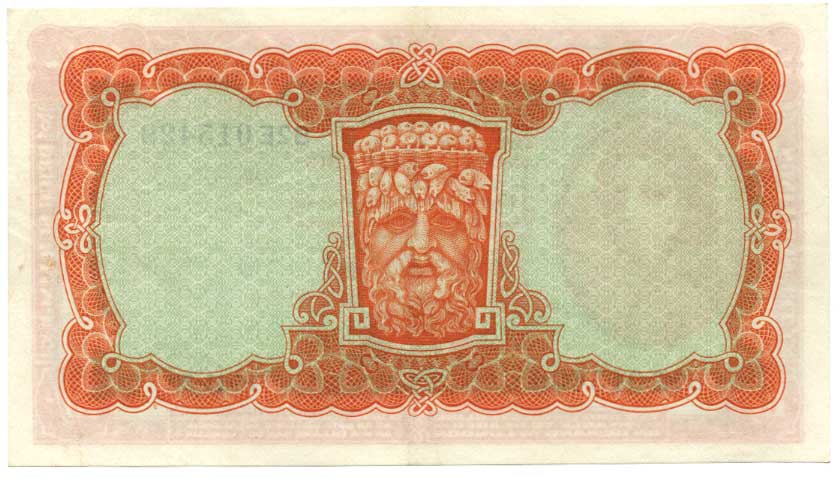
Extremely Fine (EF). Note the counting crease on the left middle. The note has also a light vertical fold in the middle. Note that the corners are not perfectly sharp.
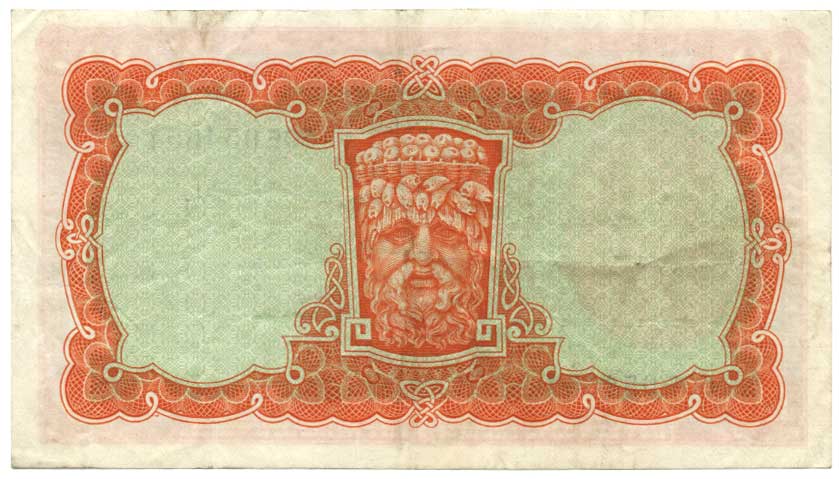
Good Very fine (gVF), apart from the slight grubbiness. This note is illustrated because the slightly grubby areas point to where the creasing areas are located.
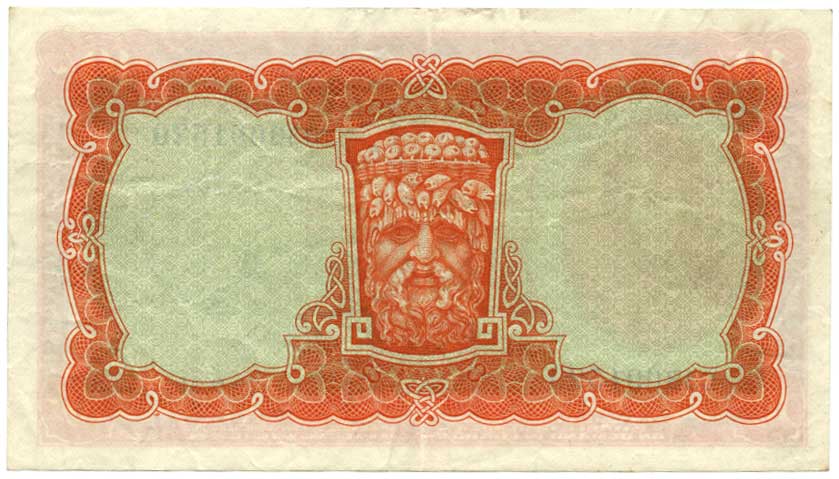
Very fine (VF). Several significant creases.

Fine (F). Heavy folds evident. Slight grubbiness is allowable. Significant grubbiness, as on the note below, should be mentioned in addition to the grade.
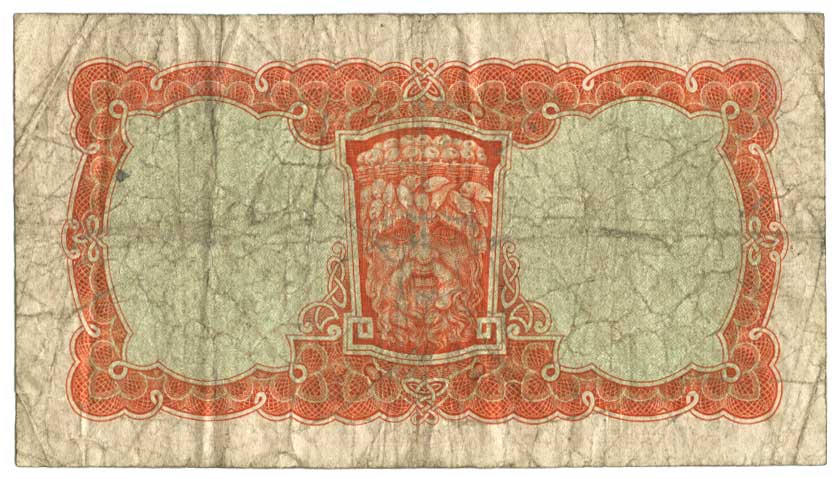
Very Good (VG).

Good. The lowest collectible grade, though some would argue that it is too low a grade for collectability. It depends on the rarity.
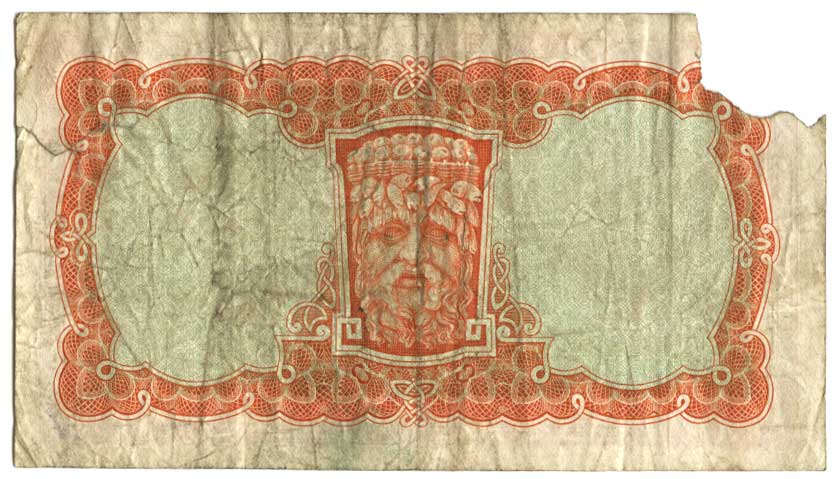
Poor. Pieces missing and a severe tear on the left are evident on this note. Without the damage, the note would be VG in grade.
Slabbing paired with the Sheldon Grading Scale (a numerical grading scale ranging from 1–70, with 60–70 being described as Uncirculated, UNC) has gained a foothold in international sales of some higher denomination Irish notes in UNC.
It has been observed that a banknote graded 67EPQ or higher corresponds to Strict UNC, that is a banknote as issued with four sharp original corners and no signs of handling. Irish banknotes graded at 67EPQ or higher have been doing very well in auctions. Generally, prices realised for graded Irish banknotes at 66EPQ or lower are much less than 67EPQ.
EPQ, Exceptional Paper Quality, or its equivalent, is a classification which may be added in addition to the grade of a banknote which indicates that the note is in original condition without any flaws such as water damage and fingerprints, or pressing and cleaning.
This section will be added to with the inclusion of higher grade notes. Comments on this grading article can be made on the forum.